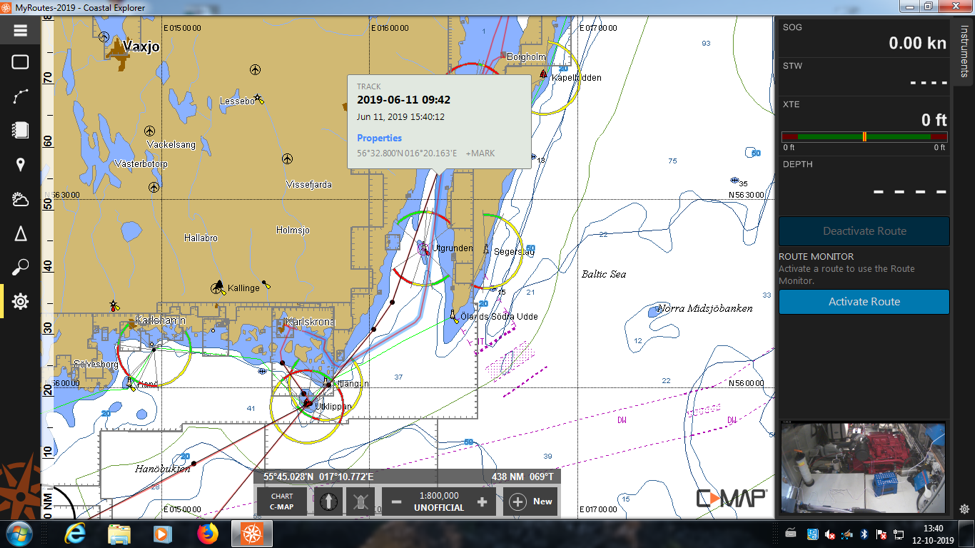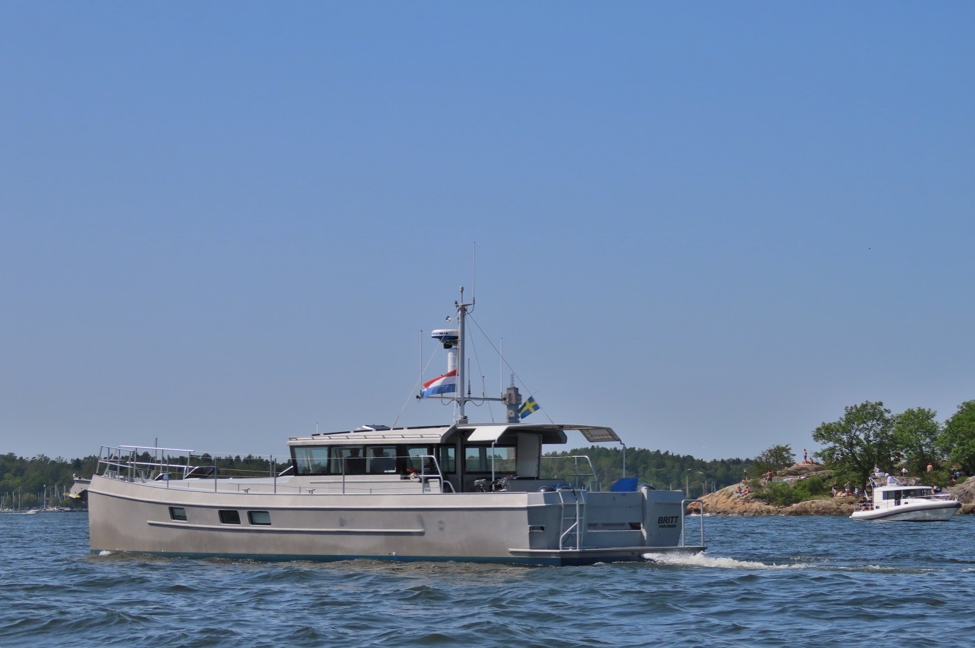1650 NM to the Baltic on an LRC-58
- artnauticaeu
- Jan 10, 2023
- 5 min read
Updated: Mar 28, 2023
Artnautica designs span from the LRC58 and 65 feet to the two heavyweight XPM models at 78 and 85 feet. A total of 14 long sleek Artnautica hulls are now sailing or in production, with the second LRC65 signed in December 2022. Five LRC58s are now sailing from yards in the Netherlands and New Zealand. The LRC58 is a long-range cruiser for coastal and near-sea cruising in comfort, speed, and superb economy.
This is the story of such a trip on LRC58-03 Britt; she was also featured recently on YouTube. Short form Story - 1650NM N Sea and Baltic at < 1 liter fuel per NM. Some dodgy weather, happy Dutchmen, great trip!
Below is the Long Form Story by Rob Westermann, Artnautica Europe.
Summer trip to the Baltic from May 21 to August 1, 2019, of Britt, a single engine 90 HP LRC58. Britt sailed the first step of a return trip with two crew in three days (90 nm, 76 nm, 53 nm) from the isle of Vlieland, The Netherlands, to Kiel-Holtenau and onwards to Stockholm, Sweden. The engine ran for approximately 230 hours, and a distance of about 1640 nm was covered. Britt's bottom was not cleaned since the bottom growth was marginal (with a clean bottom, however, we expect, on average, to sail 0.5-1 kn faster).
During the first half of the trip, the weather was wet and cold, and sometimes windy. We used the heater frequently; welcome to the North Sea! The second half of the trip was much nicer. There were a lot of headwinds with force varying between Bf 0-6 (0-27 kn) and Bf 7 (28-33 kn).
Vessels behavior & handling
We added cleats to the port and starboard aft deck, which is convenient when maneuvering in locks and docking. Since we encountered some stiff winds, the somewhat overrated Sidepower thruster proved a good choice. Twice we experienced sustained winds of Bf 6-7 (27-33 kn). Once because we were denied a berth in Heiligerhafen (Holy Harbor sic!), we had to retreat to Fehmarn Isle, and the second time on the North Sea, approximately one and a half hours to enter Lauwersoog (with wind against the current). On both occasions, Britt handled this type of weather and accompanying wave patterns nicely and with an excellent SOG of about 7 knots which were very good for our morale. https://www.youtube.com/shorts/8VY6p1t_rJQ
On July 27, the weather forecast in the morning was for Bf 6 (22-27 kn) and later for Bf 7 (28-33 kn) from the East. We left Gedser Denmark at 08:15 and did a downwind run of 38 nm. The engine ran at 2150 revs. The waves at the stern were huge, and Britt sailed up to 9.3 knots in the surfs though the course stayed true with no tendency to bow steer beyond a few degrees either way.
Around midday, we arrived at Heiligenhafen, but we were denied a spot in the harbor.
So we went back upwind another 10 nm before we could safely find a berth. And guess what. The wind was blowing at Bf 7 (28-33 kn), so Britt got a beating for an hour and a half. We still managed to do 6,5, to 7 knots SOG. I estimated the wave height to be over 2 m. But everything worked out fine, so we now could add another experience to Britt's track record.
On July 31, we did the last track to NL on the North Sea from the German isle of Norderney to Lauwersoog (roughly 50 nm). The weather forecast was for Bf 3-5 (10-20 kn) SW at the start and Bf 4-6 (15-27 kn) SSW at the end with rain showers and most likely more wind. We started at 10:00 in the morning, just 1,5 hours before high tide. The engine ran at 2175 revs. Around noon, the current changed so we could benefit from the ebb tide towards NL.
The plan was to be at the channel entrance around slack tide. Unfortunately, the wind was against the tide, so while the wind was at Bf 4,5 (15-20 kn), it worked fine. However, around 14:30, we ran into a heavy squall (30-35 kn), and the waves started to build up accordingly (>2 m). Again Britt got a beating for 1,5 hours, but actually, she did fine. as wavelength was better (read longer) than in the Baltic. We did slow down a bit (2000 revs) for 15 minutes or so to adjust for the head seas. We entered the harbor shortly after 17:00, so we did the 50 nm run in just over 7 hours. Quite a good one.

In the harbor, customs visited and told us that a commercial motor catamaran had a very rough time in the same weather. I had seen it doing 15 kn via AIS on a similar track. She had to back down in speed and retreat to Lauwersoog.
Britt did roll but not excessively, so we did not deploy the stabilizers. While pitching, in most cases, Britt sailed easily thru the waves. However, if a couple of large waves were close to each other, she would slam with her forefoot. I suspect this behavior will not happen out on the ocean with its longer wavelength.
Overall fuel consumption is a little difficult to calculate as we used the Kabola diesel boiler for heating and hot water. However, we estimate something less than 1 liter per NM from previous and subsequent voyages. This is affected by sea state, hull condition, speed, and significant weather..... but it has always remained at the level of background noise rather than major operating costs.
Rob Westermann, owner of LRC58-03 Britt
Performance of Specific Yacht Systems
Yacht Stabilizers (active fins from Matns)
The stabilizers were not used a lot. The motor vessel Britt's (15 tons and 95 cm draft) movements resemble the movements of the sailboat Britt (35 tons with 140-280 cm draft). Using the stabilizers, however, does make a difference. It should be added that Matns still needed to guide how to adapt the fins except for setting the fin reaction time and letting the system adjust to the wave direction. The waves were frequently very short and steep in the Eastern part of the Baltic. In some tracks, we had to change our course because of the wave pattern produced by the wind to let Britt create better behavior for the crew. The track from Karlskrona to Kalmar was an example. See the track from CE above.
Main engine (Beta Marine 90 HP)
We burned roughly 2100 liters of fuel (for a trip of 1640 nm). The generator only ran for two hours, and the Kabola also uses fuel. The Kabola is used daily for the galley, shower, and heating of the wheelhouse and salon. In most cases, the engine ran at 2150 revs, amounting to 8-9 kn SOG give or take, depending on the wind direction and current. At the start, the fuel tanks contained +- 2800 ltrs, and the water tank (1100 ltrs) was kept full throughout.
Solar panels
Before the start of the trip, four Panasonic solar panels were installed (combined output of 980 Wp). On sunny days at the dock and with the panels positioned correctly relative to the sun, the panels quickly cover the daily power need (about 120 Amps @ 24V).
Navigational systems
The Furuno instrument set works as it should, except for the AP, which produced the Drive Unit Failure error frequently (on average once a week vs. two times last year). This is a nuisance because the unit has to be switched off and on again while sailing. After posting this error on the USA Furuno forum (search for autopilot and nickname Britt), this issue was solved at the end of our trip. The upside is that I now know the Furuno AP settings intimately.
Designer's note, Dennis Harjama, Artnautica Yacht Design:
"Sounds like you have had an eventful journey on Britt. Glad to hear she is handling it well. You are right; in ocean waves, there is no banging from the hull. Like you say, short waves in succession can lift the bow enough so a wave can hit the hull near amidships, where there is less V in the transverse shape."









